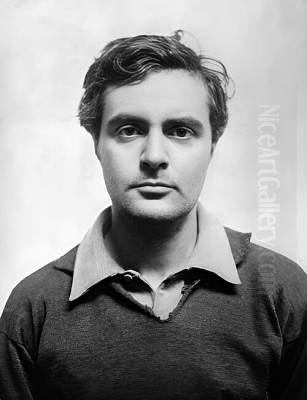
Amedeo Modigliani stands as one of the most distinctive and poignant figures of early 20th-century art. An Italian painter and sculptor who worked primarily in France, he developed a unique and instantly recognizable style, characterized by elongated forms and hauntingly expressive portraits. His life, tragically cut short, was as dramatic and turbulent as his art was elegant and refined. Living and working amidst the vibrant, revolutionary art scene of Paris, Modigliani navigated poverty, illness, and intense relationships, channeling his experiences into works that continue to captivate audiences with their melancholic beauty and profound humanity.
Early Life and Italian Roots
Amedeo Clemente Modigliani was born on July 12, 1884, in Livorno, a port city in Tuscany, Italy. He was the fourth child in a Sephardic Jewish family whose fortunes had seen better days. His father, Flaminio Modigliani, came from a family of entrepreneurs, but their business ventures had largely failed by the time Amedeo was born. His mother, Eugénie Garsin, French-born and highly educated, became the stabilizing force in the family, running a school and providing translation services. She recognized and nurtured Amedeo's artistic inclinations from a young age.
Modigliani's childhood was marked by recurring bouts of serious illness. He suffered from pleurisy at age eleven and, significantly, contracted typhoid fever at fourteen. During a delirious state brought on by the fever, he reportedly raved about seeing the masterpieces of Italian art in Florence, solidifying his desire to become an artist. His mother promised to take him to Florence once he recovered, a promise she kept. Perhaps most consequentially for his short life, he contracted tuberculosis around the age of sixteen, a disease that would plague him intermittently and ultimately lead to his early death.
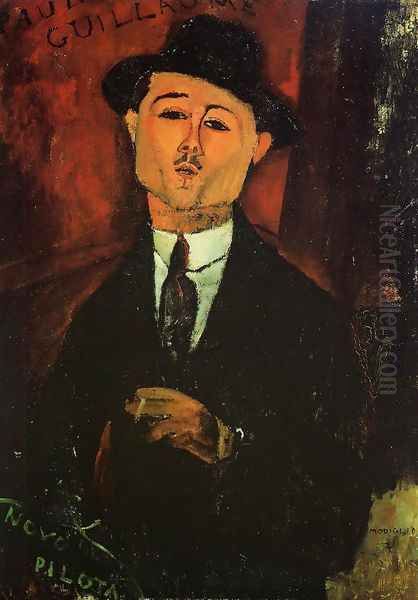
His formal art education began in Livorno in 1898, studying under Guglielmo Micheli. Micheli's studio provided a grounding in traditional 19th-century Italian art styles. Here, Modigliani was exposed to the work of the Macchiaioli, a group of Italian painters considered precursors to Impressionism, known for their plein-air painting and bold brushwork. Giovanni Fattori, a leading figure of the Macchiaioli and Micheli's own teacher, was a significant, albeit indirect, influence. Modigliani later continued his studies, briefly attending the Scuola Libera di Nudo (Free School of Nude Studies) in Florence in 1902, and then the Istituto di Belle Arti in Venice in 1903, where he first encountered Impressionism and Symbolism and reportedly began experimenting with hashish.
The Parisian Crucible
In 1906, at the age of 21, Modigliani moved to Paris, the undisputed center of the avant-garde art world. With some money from his mother, he initially settled in Montmartre, renting a studio in Le Bateau-Lavoir, a commune famous for housing artists like Pablo Picasso. Paris was a melting pot of artistic innovation, buzzing with movements like Fauvism and the nascent Cubism. Modigliani, initially presenting himself as a sculptor rather than a painter, immersed himself in this stimulating environment.
He quickly fell into the bohemian lifestyle characteristic of the Parisian art scene. He frequented cafés, engaged in intense discussions about art, and began forming connections with fellow artists and writers. His striking Italian looks, combined with a certain aristocratic bearing (despite his poverty), made him a noticeable figure. However, his life in Paris was also marked by increasing dependence on alcohol, particularly absinthe, and drugs. This, coupled with his chronic poverty and underlying tuberculosis, contributed to his volatile reputation and deteriorating health.
He later moved to Montparnasse, which was supplanting Montmartre as the hub for the artistic avant-garde. Here, his circle expanded to include figures like Chaim Soutine, Moïse Kisling, Diego Rivera, Max Jacob, and Jean Cocteau. Despite his often difficult personality, exacerbated by substance abuse, he formed significant friendships and artistic connections that would shape his career, even if commercial success largely eluded him during his lifetime.
Development of a Unique Style
Modigliani's artistic style evolved significantly during his time in Paris, synthesizing diverse influences into something entirely his own. His Italian background provided a foundation in classical linearity and Renaissance elegance, echoes of which can be seen in the graceful lines of his figures, sometimes reminiscent of Sandro Botticelli or Sienese primitives. In Paris, he absorbed the lessons of Post-Impressionism, particularly the structural concerns of Paul Cézanne and the expressive line of Henri de Toulouse-Lautrec.
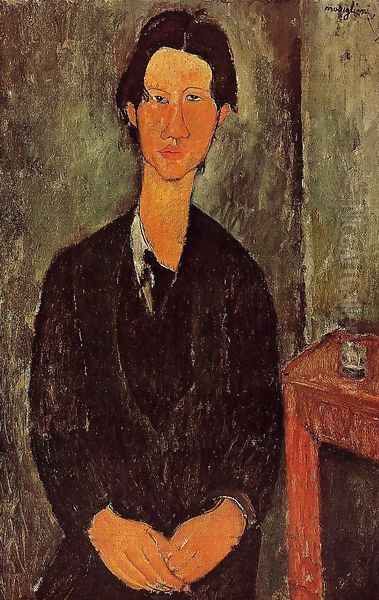
A pivotal influence came from non-Western art, particularly African masks and sculptures, which were fascinating many Parisian artists at the time, including Picasso and André Derain. Modigliani was captivated by the simplified forms, elongated features, and spiritual intensity of these objects, often seen at the Trocadéro ethnographic museum. He incorporated these elements – the oval faces, almond-shaped eyes often devoid of pupils, small pursed mouths, and elongated noses and necks – into his own work, creating mask-like visages that convey a sense of mystery and inner contemplation.
He also looked to archaic sculpture from Egypt, Greece (Cycladic and Archaic periods), and even Cambodia. While aware of Cubism, developed by his contemporaries Picasso and Georges Braque, Modigliani largely resisted its fragmentation of form. He adopted some aspects, like simplified geometric planes and a muted palette at times, but his primary focus remained on the human figure rendered with a distinctive linear elegance rather than deconstruction. His style became a unique fusion: the grace of Italian tradition blended with the formal simplifications of "primitive" art and the modern spirit of Paris.
Focus on Portraiture
Although he initially saw himself primarily as a sculptor, painting, especially portraiture, became the main focus of Modigliani's output. He painted his friends, lovers, fellow artists, poets, and patrons – the inhabitants of his Montparnasse world. His portraits are rarely straightforward likenesses; instead, they aim to capture an inner essence or psychological state, often imbued with a characteristic melancholy or serene detachment.
His sitters included many notable figures of the time. He painted portraits of fellow artists like Picasso, Juan Gris, Diego Rivera, Chaim Soutine, Moïse Kisling, and Jacques Lipchitz. He depicted poets and writers such as Max Jacob, Jean Cocteau, and Blaise Cendrars. His art dealers, Paul Guillaume and particularly Léopold Zborowski, who became his main supporter in his later years, were frequent subjects. His lovers, including the English writer Beatrice Hastings and his final partner, the young art student Jeanne Hébuterne, were immortalized in numerous canvases.
These portraits share his signature stylistic traits: the elongated necks and faces, the simplified features, the often blank or almond-shaped eyes, and a sense of quiet dignity. Even when depicting known individuals, Modigliani filtered their appearance through his distinctive artistic lens, creating images that are as much about his own vision and feeling as they are about the sitter. His portraits stand as a unique gallery of the bohemian world of early 20th-century Paris.
The Sculptural Interlude
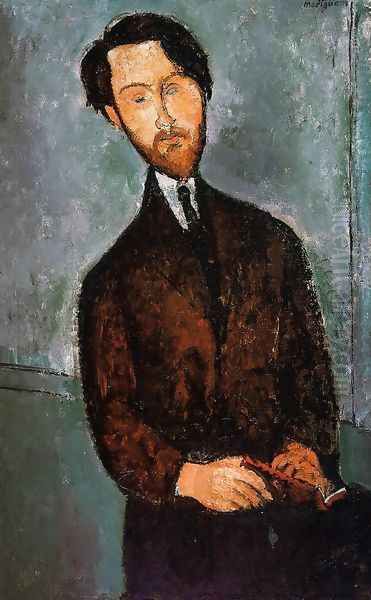
Between approximately 1909 and 1914, Modigliani devoted himself almost exclusively to sculpture. This shift was significantly encouraged by his friendship with Constantin Brancusi, the Romanian sculptor whose radical simplification of form deeply impressed Modigliani. Brancusi, who became a neighbor and mentor figure, likely guided Modigliani in the technique of direct carving in stone, a departure from the modeling techniques more common at the time.
Modigliani's sculptures consist primarily of heads and, less commonly, full figures like caryatids (sculpted female figures serving as architectural supports). Carved directly from limestone, these works exhibit a powerful synthesis of influences. The elongated features, narrow noses, and serene expressions clearly connect to his paintings but find a stark, monumental presence in stone. They draw heavily on archaic sources: the simplified geometry of Cycladic idols, the hieratic stillness of Egyptian statues, the stylized forms of African masks (particularly Baule masks from Ivory Coast), and the elegance of Greek archaic Kouroi and Korai.
His series of sculpted heads, simply titled Tête, are among his most powerful works. They possess a timeless, almost ritualistic quality. The caryatid figures, often rendered in preparatory drawings as well, show his engagement with classical motifs reimagined through a modern, primitivist lens. Ultimately, Modigliani abandoned sculpture around 1914. The physical demands of carving were likely too strenuous given his worsening tuberculosis, and the cost of materials was prohibitive for the perpetually impoverished artist. He returned to painting, bringing the formal lessons learned from sculpture – the emphasis on line, simplified volume, and elongated form – back to his canvases.
The Controversial Nudes
While Modigliani painted nudes throughout his career, the series created primarily in 1917 represents a peak in his exploration of the genre and generated significant controversy. Commissioned by his dealer Léopold Zborowski, who provided him with models and a studio, Modigliani produced around 22 reclining nudes and several seated nudes during this period. These works are celebrated today for their sensual elegance, frankness, and modern sensibility.
Unlike the idealized or mythological nudes common in academic tradition, Modigliani's nudes are intimate and direct portrayals of contemporary women. Rendered in warm, luminous colors and characterized by his signature elongated lines, they possess a languid sensuality. While often compared to Renaissance masters like Titian or Giorgione for their reclining poses and rich color, Modigliani's nudes are distinctly modern in their unidealized depiction and psychological presence.
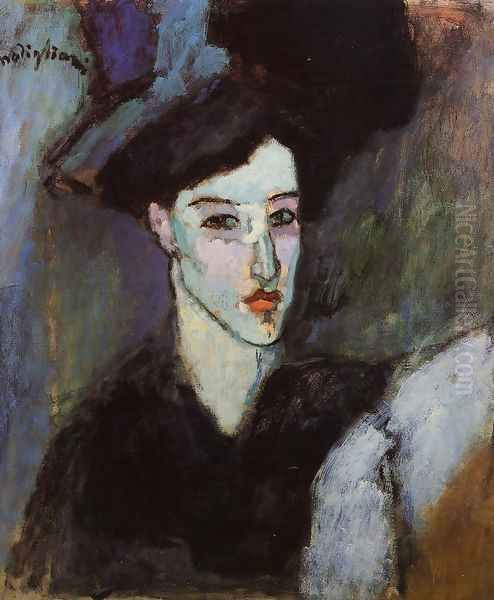
In December 1917, Zborowski arranged Modigliani's only solo exhibition during his lifetime at the Galerie Berthe Weill in Paris. Several of the new nudes were displayed, including one prominently placed in the gallery window. The exhibition caused a scandal. The local police chief, offended by the perceived indecency of the paintings – particularly the depiction of pubic hair, which was highly unusual at the time – demanded the immediate closure of the show on its opening day. The incident highlighted the conservative tastes Modigliani's work often confronted, but the nudes themselves have since become iconic examples of modern figurative painting.
Relationships and Personal Life
Modigliani's personal life was as intense and tumultuous as his artistic environment. His bohemian existence in Paris was characterized by extreme poverty, heavy drinking, and frequent use of hashish. While some accounts suggest he used substances to mask the symptoms of his tuberculosis or cope with artistic frustration, his self-destructive behavior undoubtedly exacerbated his health problems and contributed to his reputation as a peintre maudit (cursed painter).
He was known for his charm and good looks, and had numerous affairs. One significant relationship was with the English writer and intellectual Beatrice Hastings, from 1914 to 1916. Their time together was passionate but stormy, marked by mutual inspiration (she posed for many portraits) and frequent, alcohol-fueled quarrels.
His final and most profound relationship was with Jeanne Hébuterne, a young art student from a conservative Catholic background, whom he met in 1917. She became his devoted companion, muse, and the subject of many of his most tender portraits. Despite her family's disapproval, she lived with Modigliani and bore him a daughter, also named Jeanne, in 1918. Their life together was plagued by Modigliani's worsening health and continued poverty. They spent time in Nice and Cagnes-sur-Mer in the south of France, hoping the warmer climate would benefit his lungs.
The relationship ended in ultimate tragedy. Modigliani died of tubercular meningitis in a charity hospital in Paris on January 24, 1920, at the age of 35. Jeanne Hébuterne, distraught and pregnant with their second child, committed suicide by jumping from a fifth-floor window the following day. This devastating end cemented Modigliani's legend as a tragic figure of modern art.
Key Friendships and Rivalries
Living in the heart of the Parisian art world, Modigliani inevitably crossed paths with nearly every major figure of the era. His relationships were often complex, blending camaraderie, artistic exchange, and sometimes rivalry. His encounter with Pablo Picasso was significant. They met early on, likely around 1906, and shared an interest in African art. While they respected each other's talent, a rivalry developed, perhaps fueled by their differing personalities and Modigliani's resistance to fully embracing Cubism. Picasso reportedly owned several Modigliani works.
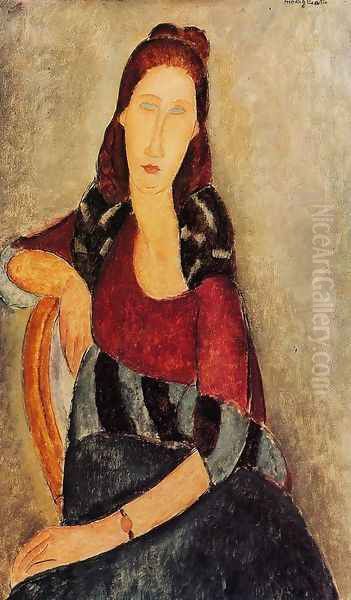
His relationship with Constantin Brancusi was more akin to mentorship, particularly regarding sculpture. Brancusi's emphasis on essential forms profoundly impacted Modigliani's sculptural work. He was also acquainted with Georges Braque, though their connection seems less documented than his interactions with Picasso. He moved within circles that included Fauvist painters like André Derain and Maurice de Vlaminck.
Among his closest friends were fellow émigré artists who shared his struggles with poverty and outsider status in Paris. Chaim Soutine, the Lithuanian expressionist painter, was a particularly close companion, known for sharing Modigliani's intense artistic dedication and bohemian hardships. Moïse Kisling, a Polish painter, was another loyal friend who helped support Modigliani in his final illness. The sculptor Jacques Lipchitz, also from Lithuania, was part of this circle and provided valuable accounts of Modigliani's life and working methods. Other artist friends included Diego Rivera and the troubled painter Maurice Utrillo, who was often a drinking companion. His network also extended to writers like Max Jacob, Jean Cocteau, and Blaise Cendrars, and supportive dealers like Paul Guillaume and Léopold Zborowski.
Representative Masterpieces
Modigliani left behind a relatively small but highly influential body of work, primarily paintings and drawings, along with his sculptures. Several works stand out as representative of his unique style and thematic concerns:
Tête (Head, c. 1911-1912): This series of limestone sculptures exemplifies his sculptural period. Influenced by Brancusi and archaic art, these elongated, serene heads possess a powerful, totemic quality, showcasing his skill in direct carving and his synthesis of diverse sources.
Portrait of Paul Guillaume (1915): One of several portraits of his early dealer, this painting shows Modigliani's mature style emerging after his return to painting. The elongated face, simplified features, and mask-like quality are evident, yet it captures a sense of the sitter's personality.
Portrait of Chaim Soutine (1916): Depicting his close friend, this portrait conveys intensity and psychological depth through minimal means. The characteristic elongation and asymmetry capture Soutine's brooding presence.
Reclining Nude (Nu couché) (1917): Perhaps his most famous painting, this iconic work from the controversial 1917 series epitomizes his approach to the nude. Its languid pose, warm colors, bold outlines, and direct gaze combine sensuality with modern elegance. It fetched one of the highest prices ever paid for a painting at auction in 2015.
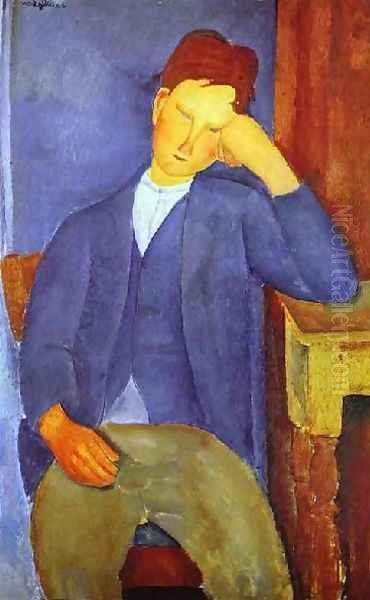
Portrait of Léopold Zborowski (1917-1919): Modigliani painted his devoted dealer numerous times. These portraits often show Zborowski in thoughtful poses, rendered with the artist's typical stylistic exaggerations, conveying both the sitter's intellectual nature and the artist's affection.
Portrait of Jeanne Hébuterne in a Large Hat (1918): One of many portraits of his final partner, this work captures Jeanne's youthful grace and melancholy beauty. The swan-like neck, tilted head, and vacant eyes are signature Modigliani elements, creating an image of haunting tenderness.
The Jewess (c. 1908): An earlier work, this painting shows the influence of artists like Toulouse-Lautrec but already hints at Modigliani's developing interest in expressive line and psychological portrayal.
Controversies and Legacy
Modigliani's life and work have been subject to various controversies and mythmaking. The scandal surrounding his 1917 nude exhibition was the most significant controversy during his lifetime. Posthumously, the main issue has been the proliferation of fakes and forgeries. His distinctive style, while unique, is relatively easy to imitate superficially, leading to numerous authentication challenges. A notorious incident occurred in 1984 when three sculpted heads, supposedly newly discovered Modigliani works dredged from a canal in his hometown of Livorno, were briefly celebrated before being revealed as a hoax perpetrated by local students. More recently, exhibitions have faced scrutiny, such as a 2017 show in Genoa where a significant number of works were declared fakes.
His tragic life story – the poverty, illness, substance abuse, and the dramatic deaths of himself and Jeanne Hébuterne – has contributed to a romanticized myth of the "cursed artist." While based in fact, this narrative sometimes overshadows serious consideration of his artistic achievements and dedication to his craft. Despite his chaotic lifestyle, contemporaries noted his deep knowledge of art history and his serious approach to his work when sober.
Modigliani achieved little recognition or financial success while alive. His fame grew exponentially after his death, particularly from the 1930s onwards. Today, his works command extremely high prices on the art market, and he is widely regarded as a major figure of the School of Paris. His legacy lies in his unique synthesis of tradition and modernity, his unwavering focus on the human figure in an era increasingly dominated by abstraction, and his creation of a deeply personal style that conveys both elegance and profound emotion.
Enduring Influence
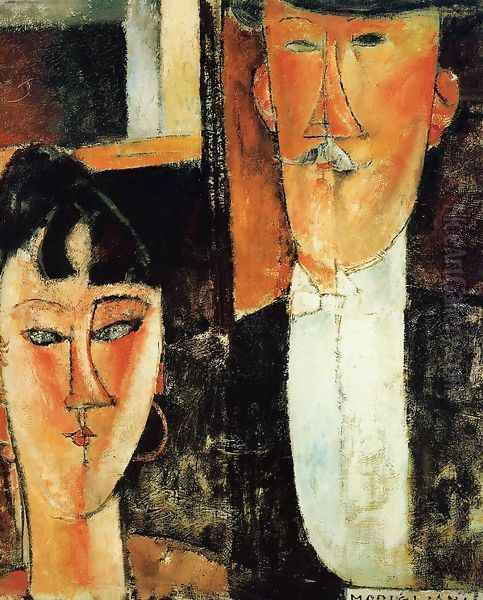
Amedeo Modigliani's impact on subsequent generations of artists has been significant, though perhaps less direct than that of stylistic innovators like Picasso or Matisse. His primary influence lies in his distinctive approach to figurative art, particularly portraiture. His ability to convey psychological depth and emotion through stylized elongation and linear grace offered an alternative path for artists seeking expressive figuration outside of pure abstraction or academic realism.
His work resonated with artists who explored the human form with emotional intensity. Figures associated with Expressionism and later figurative movements found inspiration in his melancholic and soulful depictions. While specific stylistic imitation is less common, his general approach to simplifying form while retaining emotional weight can be seen as a precursor to aspects of the work of artists like Alberto Giacometti, whose elongated figures share a similar existential quality, or even Francis Bacon, in terms of the psychological intensity of the portrait.
British modernists like Henry Moore and Barbara Hepworth acknowledged the influence of archaic and non-Western sculpture, interests they shared with Modigliani via Brancusi. The directness and sensuality of his nudes also contributed to the ongoing evolution of depicting the human body in modern art. Artists like Frida Kahlo, known for her deeply personal and emotionally charged self-portraits, operated in a lineage where capturing inner states, as Modigliani did, was paramount. His enduring appeal lies in this combination of formal elegance and raw emotional honesty.
Conclusion
Amedeo Modigliani remains a compelling and somewhat enigmatic figure in the history of modern art. His life, a whirlwind of artistic passion, bohemian excess, and tragic illness, produced a body of work characterized by a singular, haunting beauty. He forged a unique path, drawing inspiration from the masters of the Italian Renaissance, the innovations of the Parisian avant-garde, and the powerful forms of ancient and non-Western art, yet ultimately creating a style that was unmistakably his own. Through his elongated portraits and sensual nudes, Modigliani explored the complexities of the human spirit, leaving behind images that continue to resonate with their blend of refined elegance and profound, often sorrowful, humanity. His brief but incandescent career serves as a testament to the enduring power of figurative art to convey the depths of human experience.